Property Record
418 N DEWEY ST
Architecture and History Inventory
| Historic Name: | Sacred Heart Church |
|---|---|
| Other Name: | Sacred Heart Church |
| Contributing: | |
| Reference Number: | 29215 |
| Location (Address): | 418 N DEWEY ST |
|---|---|
| County: | Eau Claire |
| City: | Eau Claire |
| Township/Village: | |
| Unincorporated Community: | |
| Town: | |
| Range: | |
| Direction: | |
| Section: | |
| Quarter Section: | |
| Quarter/Quarter Section: |
| Year Built: | 1928 |
|---|---|
| Additions: | |
| Survey Date: | 1981 |
| Historic Use: | house of worship |
| Architectural Style: | Romanesque Revival |
| Structural System: | |
| Wall Material: | Brick |
| Architect: | Foeller and Schober |
| Other Buildings On Site: | |
| Demolished?: | No |
| Demolished Date: |
| National/State Register Listing Name: | Sacred Heart Church |
|---|---|
| National Register Listing Date: | 3/3/1983 |
| State Register Listing Date: | 1/1/1989 |
| National Register Multiple Property Name: | Multiple Resources of Eau Claire |
| Additional Information: | The reddish-brown brick Sacred Heart Church is an apsidal structure covered by a gable roof. Twin front towers and side aisles lining the nave of the building project from the main block. The square towers, mirror images, highlight the design and depart from the style's more commonly observed pattern of unmatched towers. Lantern-like belfries mark the uppermost stage of the corner features. The belfries' openings are round arched and the crowning domical roofs, each supporting a Latin cross, are metal covered. Blind arcades identify the polygonal section between the belfries and the square tower bases, which feature narrow two story round arched openings on three sides. The church's main gable includes a large rose window divided in wagon wheel fashion. Below are five small round arched windows with pronounced archivolt trim. At the ground level a shallow pavilion encompasses three side-by-side entrances all contained within compound arches. This lower floor is further distinguished by an arcade-like corbel table, a feature repeated above the rose window outlining the pitch of the gable roof and along the eaves of the north and south facades. These facades are defined by additional round arch windows. The side aisles are characterized by long openings separated by thin pilasters, while the upper walls are punctuated by five groups of three windows with the center opening a larger version of its flanking neighbors. A small wooden cupola straddling the roof ridge near the rear of the church marks the interior altar area. The interior of Sacred Heart Church, featuring a vault ceiling and heavy columns supporting the side aisle area, has bene redecorated (repainted, etc.) in 1939, 1970, and 1981-82. The three altars - main and side altars - are the original Italian marble features. Protective windows cover all of the church's stained glass openings including the large rose window on the main facade. Erected in 1928, Sacred Heart Church is a locally destinguished example of late Neo-Romanesque architecture. The imposing church structure, located on a bluff overlooking the city, is a prominent visual feature of the city's commercial and residential center. Characterized by identical twin towers,, an over-sized rose windows, and a multiplicity of round arched openings, the church contributes significantly to the quality and variety of Eau Claire's architectural heritage. Eau Claire's first Catholic congregation was organized in 1858 by Father Napoleon Mignault of the Catholic church in nearby Chippewa Falls. A church was erected on N. Barstow Street and the mission named St. Peter's. In 1865 the parish was officially established and the name changed to St. Patrick's. Ten years later Sacred Heart Church was founded when a number of German-speaking families formed a separate parish. Father Paul Geyer was Sacred Heart's first pastor. A frame church and school were erected immediately but they were replaced by brick structures - the church in 1880 and the school in 1910. Sacred Heart Hospital, founded in 1889 and located approximately half a block north of the church, was also part of the complex. Today the hospital buildings contain the Eau Claire Academy, a child and adolescent treatment center. In 1921 Father Farncis Orthen became pastor of Sacred Heart and was responsible for the construction of the present church building. It was dedicated on May 1, 1929 by the Most Reverend Alexander McGavick, Bishop of LaCrosse. (B,C) In 1999, a new parish, Sacred Heart of Jesus-St. Patrick, recombined the two oldest Catholic congregations in the city. 2016- "Located on a prominent bluff overlooking the city, Sacred Heart Church is characterized by identical metal-covered twin towers, each supporting a Latin cross. Rose-colored windows and round arched openings are significant feautres of the building. Eau Claire's Catholics organized a congregation in 1858 and constructed a small frame church on North Barstow Street. Originally called St. Peter's Church, it was renamed St. Patrick's in 1865. About ten years later, sixty German-speaking families left the church to form their own parish, Sacred Heart. They built a frame church and school on this site but soon replaced them with brick structures, a church in 1880 and a school in 1910. Sacred Heart Hospital, founded in 1889, was constructed just north of that church. The present church building was completed in 1928. In 1999 a new parish, Sacred Heart of Jesus-St. Patrick, recombined the two oldest Catholic congregations in the city." -"Eau Claire Landmarks: Designated Historic Properties in Eau Claire, Wisconsin", Eau Claire Landmarks Commission, P.O. Box 5148, 2016. |
|---|---|
| Bibliographic References: | (A) Building inscription. (B) History of Eau Claire County, 1914, p. 512. (C) Barland, L. 1965. The Rivers Flow On, p. 312. (D) ARCHITECTURAL STYLES OF HISTORIC PROPERTIES IN EAU CLAIRE, EAU CLAIRE LANDMARKS COMMISSION 1993. (E) HISTORIC PRESERVATION FOUNDATION NEWS, V.6, #3, SEPT.-DEC. 1994. Eau Claire Landmarks booklet published by the Landmarks Commission in 2002. |
| Wisconsin Architecture and History Inventory, State Historic Preservation Office, Wisconsin Historical Society, Madison, Wisconsin |





